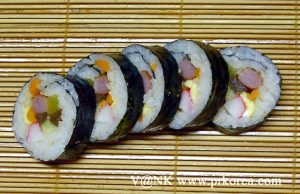 “Oh, you mean Korean sushi?”
“Oh, you mean Korean sushi?”
One of my top three Korean foods is no doubt Gimbap. One of the most common misconceptions about Gimbap is that it’s Korea’s version of sushi. Although I understand the thought process, Gimbap is not “Korean sushi”.
Sushi originates from Japan back when fermented rice was used to prevent fish from spoiling. After Japan invented seaweed paper around 1750 during the Edo period (1603-1868), fresh fish was served over vinegared rice and the seaweed paper. The earliest written mention of “sushi” dates back to an 1873 Japanese-English dictionary authored by James Hepburn. However, Norimaki, a type of sushi, was first introduced in 1750 Japan. Sushi is essentially a food made with vinegar rice. ‘Su’ meaning Vinegar and ‘Shi’ meaning to make. There are many types of sushi and because Maki-sushi (Japanese sushi roll) looks similar to Gimbap, many people suspect Gimbap to be an imitation of Japanese sushi.
The origin of Gimbap, however, is still up for grabs. Some believe that it was born out of the Japanese occupation of Korea between 1910-1945. Some believe that it was a development from tradition of rolling cooked rice and side dishes in seaweed. Others even believe that Korea introduced Japan to the idea back during the Baekje period (18BC- 660AD). The term “gimbap” was used in a 1935 Korean newspaper, however the term “norimaki” was also used interchangeably at that time. ‘Gim’ refers to edible seaweed and ‘Bap’ refers to cooked rice. Gimbap has many variations but typically the traditional versions consist of carrots, pickled radish, fried egg, spinach, fish cake, and marinated beef.
Therefore, the key difference between Sushi and Gimbap is the vinegared rice. Gimbap has its own distinct identity despite its similarities to sushi. Gimbap usually has no raw meats and there are many delicious variations of Gimbap that are typically low-priced and nutritious.
You can find Gimbap in Korea at convenience stores or at various Gimbap restaurants. Even in America, some Korean or Asian food marketplaces may sell Gimbap. Gimbap is relatively cheap due to a roll of Gimbap only costing around $2 in Korea. Even if there are no places that sell Gimbap around, it isn’t hard to make Gimbap yourself. Simply spread out rice on a sheet of roasted seaweed and put the ingredients you want on top of the rice and roll!
Written by: Caleb Rigsby
Honolulu, Hawaii. Sophomore, Korean for Professionals Major at University of Hawaii at Manoa. Intern at VANK(Voluntary Agency Network of Korea)